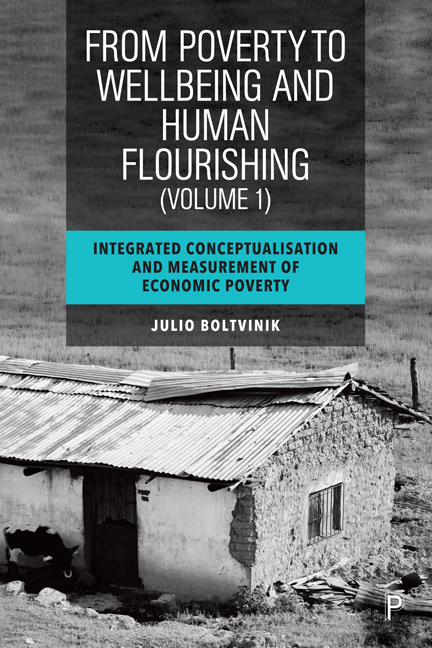 From Poverty to Well-Being and Human Flourishing
From Poverty to Well-Being and Human Flourishing 7 - Combined methods of poverty measurement
Published online by Cambridge University Press: 28 March 2024
Summary
7.1 Description and critique of combined methods included in the typology
IPMM, original variant (OV-IPMM)
Two separate explorations carried out by Beccaria and Minujin (1987) and Kaztman (1989) enquiring whether the UBN-OV and PL-NFB methods identified the same HH as poor, and obtaining negative answers, became a model for the simultaneous application of both methods. The result was a contingency table (matrix) in which HH and population were classified in four categories: poor on both; non-poor on both; poor only by UBN; and poor only by PL. To this, Boltvinik (1990a) added a poverty criterion and identified a new method: OV-IPMM, which was adopted and broadly applied by UNDP’s Regional Project to Overcome Poverty in Latin America (RLA/86/004). The method has a number of interesting features, one of which is that in certain circumstances it allows the distinction between a recently impoverished population (strongly associated with the poor only by PL in countries going through a recession or economic crisis) and a more structural type of poverty (poor on both methods). OV-IPMM also allows analysts to identify poverty of publicly provided goods. The newly adopted poverty criterion, derived from the notion of the complementary nature of both original methods (PL and UBN) and the conception of WBS explained in Chapter 1, is that only those identified by the union of both sets are poor, which means, in turn, that only HH identified as non-poor by both methods are non-poor. Nevertheless, this method has various limitations. First, it identifies only food P, as it incorporates the NFB variant in the Y dimension; second, the incidence of UBN P is not independent from the number of indicators; third, it cannot calculate the HH poverty gap IJ nor, in consequence, any other APM, except for the incidence or proportion of poor people in the population; fourth, it does not consider two WBS: FT and knowledge/abilities; and lastly, the poverty criterion is difficult to uphold: a millionaire HH not sending its child to school, for example, is considered poor.
- Type
- Chapter
- Information
- From Poverty to Well-Being and Human FlourishingIntegrated Conceptualisation and Measurement of Economic Poverty, pp. 129 - 140Publisher: Bristol University PressPrint publication year: 2023


